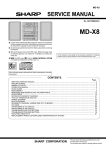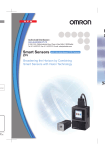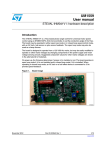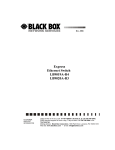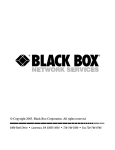Download Lead Sensing Relay
Transcript
© Copyright 1997. Black Box Corporation. All rights reserved. 1000 Park Drive • Lawrence, PA 15055-1018 • 724-746-5500 • Fax 724-746-0746 FEBRUARY 1997 SW702A SW702AE-R2 Lead Sensing Relay LEAD OUT DATA P O W E R S W I T C H E D R E S E T D I S A B L E AY G REL SENSIN UT OUTP CUSTOMER SUPPORT INFORMATION Order toll-free in the U.S. 24 hours, 7 A.M. Monday to midnight Friday: 877-877-BBOX FREE technical support, 24 hours a day, 7 days a week: Call 724-746-5500 or fax 724-746-0746 Mail order: Black Box Corporation, 1000 Park Drive, Lawrence, PA 15055-1018 Web site: www.blackbox.com • E-mail: [email protected] LEAD SENSING RELAY FEDERAL COMMUNICATIONS COMMISSION RADIO FREQUENCY INTERFERENCE STATEMENT This equipment generates, uses, and can radiate radio frequency energy and if not installed and used properly, that is, in strict accordance with the manufacturer’s instructions, may cause interference to radio communication. It has been tested and found to comply with the limits for a Class A computing device in accordance with the specifications in Subpart J of Part 15 of FCC rules, which are designed to provide reasonable protection against such interference when the equipment is operated in a commercial environment. Operation of this equipment in a residential area is likely to cause interference, in which case the user at his own expense will be required to take whatever measures may be necessary to correct the interference. Caution: Changes or modifications not expressly approved by the party responsible for compliance could void the user’s authority to operate the equipment. This digital apparatus does not exceed the Class A limits for Radio noise emission from digital apparatus set out in the Radio Interference Regulation of the Canadian Department of Communications. Le présent appareil numérique n’émet pas de bruits radioélectriques dépassant les limites applicables aux appareils numériques de la classe A prescrites dans le Règlement sur le brouillage radioélectrique édicté par le ministère des Communications du Canada. 2 CHAPTER NORMAS OFICIALES MEXICANAS (NOM) ELECTRICAL SAFETY STATEMENT INSTRUCCIONES DE SEGURIDAD 1. Todas las instrucciones de seguridad y operación deberán ser leídas antes de que el aparato eléctrico sea operado. 2. Las instrucciones de seguridad y operación deberán ser guardadas para referencia futura. 3. Todas las advertencias en el aparato eléctrico y en sus instrucciones de operación deben ser respetadas. 4. Todas las instrucciones de operación y uso deben ser seguidas. 5. El aparato eléctrico no deberá ser usado cerca del agua—por ejemplo, cerca de la tina de baño, lavabo, sótano mojado o cerca de una alberca, etc.. 6. El aparato eléctrico debe ser usado únicamente con carritos o pedestales que sean recomendados por el fabricante. 7. El aparato eléctrico debe ser montado a la pared o al techo sólo como sea recomendado por el fabricante. 8. Servicio—El usuario no debe intentar dar servicio al equipo eléctrico más allá a lo descrito en las instrucciones de operación. Todo otro servicio deberá ser referido a personal de servicio calificado. 9. El aparato eléctrico debe ser situado de tal manera que su posición no interfiera su uso. La colocación del aparato eléctrico sobre una cama, sofá, alfombra o superficie similar puede bloquea la ventilación, no se debe colocar en libreros o gabinetes que impidan el flujo de aire por los orificios de ventilación. 10. El equipo eléctrico deber ser situado fuera del alcance de fuentes 3 LEAD SENSING RELAY 11. 12. 13. 14. 15. 16. 17. 18. 4 de calor como radiadores, registros de calor, estufas u otros aparatos (incluyendo amplificadores) que producen calor. El aparato eléctrico deberá ser connectado a una fuente de poder sólo del tipo descrito en el instructivo de operación, o como se indique en el aparato. Precaución debe ser tomada de tal manera que la tierra fisica y la polarización del equipo no sea eliminada. Los cables de la fuente de poder deben ser guiados de tal manera que no sean pisados ni pellizcados por objetos colocados sobre o contra ellos, poniendo particular atención a los contactos y receptáculos donde salen del aparato. El equipo eléctrico debe ser limpiado únicamente de acuerdo a las recomendaciones del fabricante. En caso de existir, una antena externa deberá ser localizada lejos de las lineas de energia. El cable de corriente deberá ser desconectado del cuando el equipo no sea usado por un largo periodo de tiempo. Cuidado debe ser tomado de tal manera que objectos liquidos no sean derramados sobre la cubierta u orificios de ventilación. Servicio por personal calificado deberá ser provisto cuando: A: El cable de poder o el contacto ha sido dañado; u B: Objectos han caído o líquido ha sido derramado dentro del aparato; o C: El aparato ha sido expuesto a la lluvia; o D: El aparato parece no operar normalmente o muestra un cambio en su desempeño; o E: El aparato ha sido tirado o su cubierta ha sido dañada. CHAPTER 1: Specifications 1. Specifications Indicators — Power, Switched (relay activated) Controls — Reset (resets relay after trigger), Disable (prevents relay switching) Input — Ring Indicator and/or Carrier Detect Output — Dry contacts or switched AC, 5 amps Connectors — SW702A: (1) DB25 female, (1) DB25 male, (1) AC power input (through line cord), (1) standard three-wire AC power outlet; SW702AE-R2: (1) DB25 female, (1) DB25 male, (1) IEC female AC power output, (1) IEC male AC power input Power — 120/240 VAC, switch-selectable (SW702A comes set for 120 VAC; SW702AE-R2 comes set for 240 VAC) Size — 2.5"H × 8"W × 6.3"D (6.4 × 20.3 × 16 cm) Weight — 3 lb. (1.4 kg) 5 LEAD SENSING RELAY 2. Introduction The Lead Sensing Relay (or LSR, for short) uses modem signals to control external equipment: It receives RS-232 output from a modem and uses one or more signals to control a relay. You can choose whether the output is switched dry contacts or switched AC power, and whether the output is normally off (circuit open) or on (circuit closed). There’s also a switch to choose between 120-volt and 240-volt power. The output is through a standard three-wire AC power outlet (for the SW702AE-R2 version, a standard IEC female three-wire AC power outlet). Both the circuitry and the output are fuse-protected. Caution! Always disconnect the LSR from AC power when you install or disconnect it. For security, you can set the Disable switch, so that the LSR can’t be switched accidentally. If you have a special application, several customized options—timer functions, alarm functions (serial or parallel), and additional external controls—can be special-ordered. Call with your particular requirements. 6 CHAPTER 3: Configuring the LSR 3. Configuring the LSR In the simplest application, the Lead Sensing Relay’s output is wired to provide AC power to an external device, switching the power on or off when the LSR receives one or more signals from a modem. The way the LSR works is controlled by two jumpers, W3 and W4. Table 3-1 shows how the jumpers control what the LSR does. Table 3-1. Jumpers W3 and W4 Jumper How the LSR works None Output switches when CD goes high within 10 seconds of RI going high. W3 only Output switches when CD goes high. W4 only Output switches when RI goes high. W3 and W4 Output always switched (Test Mode). 7 LEAD SENSING RELAY The output is set at the factory to be switched AC power, since this is probably the most common use of the LSR. But you can easily change the setting by changing the connections at Terminal Strip TB1, which is inside the LSR. See Table 3-2. WARNING! Be careful! Circuits in the LSR carry AC line voltages and currents. A l w a y s disconnect the LSR from the AC power source before you install or service it, and use caution when you connect it to the power source and to the external equipment. Table 3-2. AC Input/Output Connections TB1/1 TB1/2 TB1/3 TB1/4 TB1/5 TB1/6 TB1/7 TB1/8 TB1/9 Normally Closed Contact Relay Contact Arm (AC Out when 3 is tied to 4) Normally Open Contact AC Out AC Neutral Out Earth (AC Ground) Out Earth (AC Ground) In AC Neutral In AC In NOTE: Remove the insulated jumper between TB1/3 and TB1/4 when using dry contacts. 8 CHAPTER 4: Installation 4. Installation Find a spot for the LSR where it will be near the modem and the other equipment to which it will be connected, and also near a source of stable AC power. Do not connect the power until the installation is complete. 1. Set the Disable switch to “Disable.” 2. Make sure the voltage switch, S2, is set to the right voltage for your power source. For LSRs shipped to North America, the switch is set to 120 volts at the factory. For LSRs shipped to other areas, the switch is set to 240 volts. If the factory setting is wrong for your area, change it. 3. Decide which leads you need to use for switching, and set Jumpers W3 and W4. See Table 3-1 (page 5). 4. Now decide what output mode you need for your application—whether switched dry contacts should be available at Positions 1, 2, and 3 of TB1: TB1/1 TB1/2 TB1/3 Normally Closed Contact Relay Arm Normally Open Contact 9 LEAD SENSING RELAY The AC outlet is wired to AC Earth Ground and AC Neutral directly, through connections TB1/6 and TB1/5. The AC terminal of the outlet is wired to the Relay Contact Arm, TB1/2. An insulated jumper connects TB1/3 and TB1/4, so that fused AC voltage is applied to the relay’s Normally Open Contact. NOTE: Remove the insulated jumper between TB1/3 and TB1/4 when using dry contacts. When the LSR is working, it connects AC power from the source through the LSR to the outlet. In Switched AC Mode, here’s how the contacts work: TB1/2 TB1/3 TB1/4 TB1/5 TB1/6 Outlet AC terminal Outlet Neutral terminal Outlet Earth terminal You can change the switch mode from normally off to normally on by removing the jumper between TB1/3 and TB1/4, and installing an insulated jumper between TB1/1 and TB1/4. 10 CHAPTER 4: Installation 5. Connect the signal-input device (usually your modem) to one of the DB25 connectors. The other connector duplicates its signals, so you can install the LSR in line between a modem output and a computer serial port. 6. Connect the line cord to the AC power source. 7. Move the Disable switch to “Active.” The Lead Sensing Relay is now ready to run. 11












